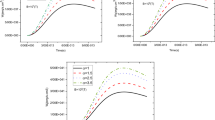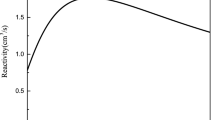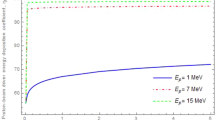Abstract
This paper investigates an analytical illustration of ignition conditions for the aneutronic reaction of proton-boron plasma in the presence of the magnetic field for fusion. In particular, the criterion for this plasma target is derived through two-temperature Lindl–Widner diagrams. Since the heating and cooling terms in the energy balance equation are affected by inequality between ions and electrons temperature combined with the impact of the magnetic field, the reduction of energy loss as well as the areal density parameter will increase the fusion rate. It will also relax the requirements of ignition conditions. Therefore, numerical derivations of ignition conditions at stagnation are performed involving the energy balance equation. The additional parameter applied other than electron and ion temperature as well as areal density is the magnetic field dependent B/ρ. It is shown that as B/ρ develops the required areal density decreases. For ions temperature of Ti < 1000 keV and electrons temperature of Te < 110 keV, the equation has real solutions for the areal density of ρR < 6 g/cm2. Furthermore, it is shown that the B/ρ parameter can be set at approximately 106 G cm3/g value. It shows the magnetic field has more effect than DT case and can reduce the driver requirements significantly. A comparison of this model with DT magnetized case shows that this model of p11B fuel is intermediate between experimental results of p11B non-magnetized and DT magnetized in the two-temperature model.






Similar content being viewed by others
REFERENCES
R. C. Kirkpatrick, High Energ. Density Phys. 6, 207–209 (2010).
I. R. Lindemuth, Phys. Plasmas 24, 055602 (2017).
D. Kilcrease and R. Kirkpatrick, Nucl. Fusion 28, 1465 (1988).
I. R. Lindemuth and R. E. Siemon, Am. J. Phys. 77, 407–416 (2009).
M. C. Hermann. M. E. Cuneo, D. B. Sinars, and S. A. Slutz, IEEE Trans. Plasma Sci. 40, 3222–3245 (2012).
A. Aksenov, M. Churazov, A. Golubev, D. Koshkarev, and E. Zabrodina, Nucl. Instrum. Methods Phys. Res., Sect. A 544, 412–416 (2005).
A. B. Sefkow, S. Slutz, J. Koning, M. Marinak, K. Peterson, D. Sinars, and R. Vesey, Phys. Plasmas 21, 072711 (2014).
V. V. Kuzenov, S. V. Ryzhkov, and V. V. Shumaev, “Application of Thomas–Fermi model to evaluation of thermodynamic properties of magnetized plasma,” Probl. At. Sci. Technol. 1 (95), 97–99 (2015).
A. J. Kemp, M. Basko, and J. Meyer-ter-Vehn, Nucl. Instrum. Methods Phys. Res., Sect. A 464, 192–195 (2001).
A. J. Kemp, M. Basko, and J. Meyer-ter-Vehn, Nucl. Fusion 43, 16 (2002).
G. A. Wurden, S. C. Hsu, T. P. Intrator, T. C. Grabowski, J. H. Degnan, M. Domonkos, P. J. Turchi, E. M. Campbell, D. B. Sinars, M. C. Herrmann, R. Betti, B. S. Bauer, I. R. Lindemuth, R. E. Siemon, R. L. Miller, M. Laberge, and M. Delage, J. Fusion Energ. 35, 69–77 (2016).
I. R. Lindemuth, Phys. Plasmas 22, 122712 (2015).
R. C. Kirkpatrick, I. R. Lindemuth, and M. S. Ward, Fusion Technol. 27, 201–214 (1995).
M. Laberge, J. Fusion Energ. 38, 199–203 (2019).
C. Cereceda, C. Deutsch, M. de Peretti, M. Sabatier, M. Basko, A. Kemp, and J. Meyer-ter-Vehn, Phys. Plasmas 7, 4515–4533 (2000).
A. J. Kemp, Ph.D. Thesis (Tech. Univ., München, 2001)
K. Schoenberg and R. Siemon, Magnetized Target Fusion. A Proof-of-Principle Research Proposal (Los Alamos Natl. Lab., NM, 1998).
M. Basko, Phys. Plasmas 7, 4579–4589 (2000).
S. Eliezer, Z. Henis, N. Nissim, S. V. Pinhasi, and J. M. M. Val, Laser Part. Beams 33, 577–589 (2015).
Z. Fan, J. Liu, B. Liu, C. Yu, and X. He, Phys. Plasmas 23, 010703 (2016).
Z. Fan, X. He, J. Liu, G. Ren, B. Liu, J. Wu, L. Wang, and W. Ye, Phys. Plasmas 21, 100705 (2014).
Z. Fan, Y. Liu, B. Liu, C. Yu, K. Lan, and J. Liu, Matter Radiat. Extremes 2, 3–8 (2017).
H. Hora, S. Eliezer, G. Kirchhoff, G. Korn, P. Lalousis, G. Miley, and S. Moustaizis, SPIE Proc. 10241, 1024114 (2017).
S. Eliezer and J. Martinez-Val, Laser Part. Beams 16, 581–598 (1998).
M. J. Hay and N. J. Fisch, Phys. Plasmas 22, 112116 (2015).
J. Martinez-Val, S. Eliezer, M. Piera, and G. Velarde, Phys. Lett. A 216, 142–152 (1996).
E. Ghorbanpour, A. Ghasemizad, and S. Khoshbinfar, Nucl. Sci. Tech. 30, 67 (2019).
E. J. Lerner, S. K. Murali, and A. Haboub, J. Fusion Energy 30, 367–376 (2011).
I. Y. Kostyukov and S. Ryzhkov, Plasma Phys. Rep. 37, 1092–1098 (2011).
J. Dawson, “Advanced fusion reactors,” in Fusion, Ed. by E. Teller (Academic, New York, 1981), Vol. 1, Part B.
S. E. Bodner, Phys. Rev. Lett. 33, 761 (1974).
R. E. Kidder, “The theory of homogeneous isentropic compression and its application to laser fusion,” in Laser Interaction and Related Plasma Phenomena, Ed. by H. J. Schwarz (Springer, Boston, 1974).
J. Meyer-ter-Vehn, Nucl. Fusion 22, 561 (1982).
M. Kundu, J. Phys.: Conf. Ser., 012068 (2016).
V. V. Kuzenov and S. V. Ryzhkov, Phys. Plasmas 26, 092704 (2019).
V. V Kuzenov and S. V. Ryzhkov, Phys. At. Nucl. 82, 1621–1626 (2019).
A. Y. Chirkov and S. V. Ryzhkov, J. Fusion Energ. 31, 7–12 (2012).
S. Atzeni and J. Meyer-ter-Vehn, The Physics of Inertial Fusion: Beam Plasma Interaction, Hydrodynamics, Hot Dense Matter (Oxford Univ. Press, New York, 2004).
H. Hora, S. Eliezer, N. Nissim, and P. Lalousis, Matter Radiat. Extremes 2, 177 (2018).
B. Levush and S. Cuperman, Nucl. Fusion 22, 1519 (1982).
S. I. Braginskii, “Transport processes in plasma,” in Reviews of Plasma Physics, Ed. by M. A. Leontovich (Consultants Bureau, New York, 1965), Vol. 1, p. 205.
L. Spitzer, Physics of Fully Ionized Gases (Courier Corporation, 2006).
M. Basko and A. Kemp, and J. Meyer-ter-Vehn, Nucl. Fusion 40, 59 (2000).
R. D. Petrasso and C. Li, Phys, Rev. Lett. 70, 3059 (1993)
A. A. Harms, in Principles of Fusion Energy (Allied Publ., 2002).
P. T. León, S. Eliezer, and J. M. Martínez-Val, Phys. Lett. A 343, 181–189 (2005).
A. Kemp, M. Basko, and J. Meyer-ter-Vehn, Nucl. Fusion 41, 235 (2001).
S. Eliezer, J. Martinez-Val, Z. Henis, N. Nissim, S. Pinhasi, A. Ravid, M. Werdiger, and E. Raicher, High Power Laser Sci. Eng., 4 (2016).
M. Basko, Association EURATOM-CEA (1998).
S. Moustaizis, P. Lalousis, H. Hora, J. Larour, P. Auvray, P. Balcou, J.-E. Ducret, and P. Martin, SPIE Proc. 9515, 95151E (2015).
J. L. Manganaro, J. Fusion Energy 22, 67–77 (2003).
D. C. Moreau, Nucl. Fusion 17, 13 (1977).
V. V. Kuzenov, S. V. Ryzhkov, and A. Starostin, Nonlin. Dyn. 16, 325–341 (2020).
M. Mahdavi and A. Gholami, Fusion Eng. Des. 142, 33–39 (2019).
Author information
Authors and Affiliations
Corresponding author
Ethics declarations
The authors declare that they have no conflict of interest.
Rights and permissions
About this article
Cite this article
Esmat Ghorbanpour, Ghasemizad, A. & Khoshbinfar, S. Non-Equilibrium Ignition Criterion for p-11B Advanced Fuel in Magnetized Target Fusion. Phys. Part. Nuclei Lett. 17, 809–820 (2020). https://doi.org/10.1134/S1547477120060126
Received:
Revised:
Accepted:
Published:
Issue Date:
DOI: https://doi.org/10.1134/S1547477120060126




